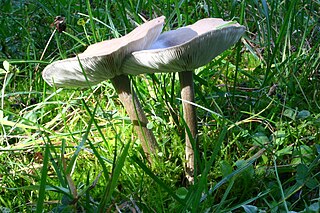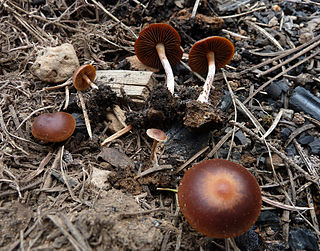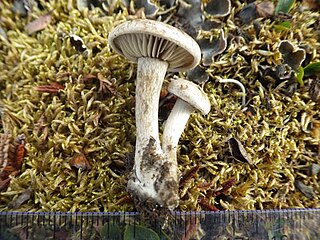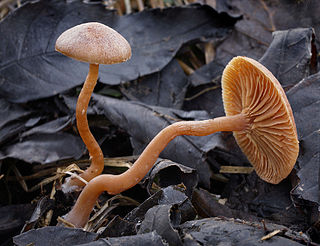
The Agaricales are an order of fungi in the division Basidiomycota. As originally conceived, the order contained all the agarics, but subsequent research has shown that not all agarics are closely related and some belong in other orders, such as the Russulales and Boletales. Conversely, DNA research has also shown that many non-agarics, including some of the clavarioid fungi and gasteroid fungi belong within the Agaricales. The order has 46 extant families, more than 400 genera, and over 25,000 described species, along with six extinct genera known only from the fossil record. Species in the Agaricales range from the familiar Agaricus bisporus and the deadly Amanita virosa to the coral-like Clavaria zollingeri and bracket-like Fistulina hepatica.

Clitocybe is a genus of mushrooms characterized by white, off-white, buff, cream, pink, or light-yellow spores, gills running down the stem, and pale white to brown or lilac coloration. They are primarily saprotrophic, decomposing forest ground litter. There are estimated to be around 300 species in the widespread genus.

Melanoleuca is a poorly known genus of saprotrophic mushrooms traditionally classified in the family Tricholomataceae. Most are small to medium sized, white, brown, ocher or gray with a cylindrical to subcylindrical stipe and white to pale yellowish gills. The basidiospores are ellipsoid and ornamented with amyloid warts. Melanoleuca is considered a difficult group to study due to their macroscopic similarities among species and the need of a thorough microscopic analysis to separate species. DNA studies have determined that this genus is closely related to Amanita and Pluteus and that it does not belong to the family Tricholomataceae.

The Crepidotaceae are a family of basidiomycete fungi.

Mythicomyces is a fungal genus in the family Mythicomycetaceae. A monotypic genus, it contains the single species Mythicomyces corneipes, first described by Elias Fries in 1861. The fungus produces fruit bodies with shiny yellowish-orange to tawny caps that are 1–3 cm (0.4–1.2 in) in diameter. These are supported by stems measuring 2–5.7 cm (0.8–2.2 in) long and 1–2 mm thick. A rare to uncommon species, it is found in northern temperate regions of North America and Europe, where it typically fruits in groups, in wet areas of coniferous forests. There are several species with which M. corneipes might be confused due to a comparable appearance or similar range and habitat, but microscopic characteristics can be used to reliably distinguish between them.

The Inocybaceae are a family of fungi in the order Agaricales, the largest order of mushroom-forming fungi. It is one of the larger families within Agaricales. This family exhibits an ectomycorrhizal ecology. Members of this family have a widespread distribution in tropical and temperate areas.
Haasiella is a fungal genus in the family Hygrophoraceae. It is a monotypic genus that contains only the species Haasiella splendidissima. Haasiella venustissima, formerly considered to be a distinct species based on its one and two-spored basidia, was found by a DNA study to be synonymous with H. splendidissima. H. splendidissima is only known from Europe and is saprotrophic on wood. Haasiella was described as a new genus in 1966 by Czech mycologists František Kotlaba and Zdeněk Pouzar. It is most closely related to the genus Hygrophorus.
Phaeomyces is a genus of fungi in the family Tubariaceae. The genus contains two species found in Europe.

Flammulaster is a genus of agaricoid fungi in the family Tubariaceae. It was formerly thought to belong in the family Inocybaceae. The genus has a widespread distribution, and contains 20 species. Flammulaster was circumscribed by American mycologist Franklin Sumner Earle in 1909.

Phaeomarasmius is a genus of fungi in the family Tubariaceae. It was formerly thought to belong in the family Inocybaceae. The genus has a widespread distribution, and contains about 20 species.

Volvopluteus is a genus of small to medium-sized or big saprotrophic mushrooms growing worldwide. The genus has been segregated from Volvariella with which it shares some morphological characteristics such as the presence of a volva and a pink to pink-brown spore print. Phylogenetic analyses of DNA data have shown that Volvopluteus is closely related to Pluteus and both genera currently are classified in the family Pluteaceae, while Volvariella is not closely related to either genus and its position in the Agaricales is still uncertain.

Pachylepyrium is a genus of fungi in the family Tubariaceae. The genus was circumscribed by Rolf Singer in 1958. The genus Pachylepyrium is widespread in northern temperate areas. Some species of Pachylepyrium have been moved to the genus Crassisporium.
Stagnicola is an agaric fungal genus that contains the single species Stagnicola perplexa. This fungus colonizes plant debris in wet coniferous forest floor depressions and shallow pools, and fruits after the pools drain or dry in late summer to early fall in North America and Europe. The genus is characterized by smooth, yellowish brown basidiospores lacking a germ pore, and a naucorioid appearance, with brownish mycelium at the base of the stems. Phylogenetically, Stagnicola appeared rather isolated and proved to be closest to Mythicomyces and Mythicomyces was closest to the Psathyrellaceae. In 2019 the two genera were shown to be closely related and placed in a new family, Mythicomycetaceae sister to the Psathyrellaceae.

Pholiota nubigena, commonly known as the gastroid pholiota or the bubble gum fungus, is a species of secotioid fungus in the family Strophariaceae. It is found in mountainous areas of the western United States, where it grows on rotting conifer wood, often fir logs. It fruits in spring, often under snow, and early summer toward the end of the snowmelt period in high mountain forests. Fruit bodies appear similar to unopened mushrooms, measuring 1–4 centimetres tall with 1–2.4 cm diameter caps that are whitish to brownish. They have a short but distinct whitish stipe that extend through the internal spore mass (gleba) of the fruit body into the cap. The gleba consists of irregular chambers made of contorted gills that are brownish in color. A whitish, cottony partial veil is present in young specimens, but it often disappears in age and does not leave a ring on the stipe.

Crassisporium is a burn-inhabiting agaric fungal genus that colonizes forest fire and campfire sites on ground and charred woody debris in Europe, north Africa and western North America. The small brownish fruitbodies have broadly attached lamellae bordered by cheilocystidia and there is an absence of pleurocystidia and chrysocystidia. Spores are thick-walled, brown, smooth, and have a germ pore. The cap surface (pileipellis) is neither gelatinized nor cellular. Clamp connections are present in the hyphae. The genus is most closely related to the genus Romagnesiella and together both are nearest the Strophariaceae or Cortinariaceae. The generic name Crassisporium refers to the thick spore walls.
Romagnesiella is an agaric fungal genus that colonizes mineral, calcareous or sandy soils in Europe and North Africa. The small brownish fruitbodies have narrowly attached, broad and distant lamellae and poorly differentiated cheilocystidia and pleurocystidia. Spores are thick-walled, brown, smooth, and lack germ pore. The cap surface (pileipellis) is somewhat cellular with irregular puzzle-like to pyriform hyphae. Clamp connections are present in the hyphae. It is most closely related to Crassisporium, both genera being close to the Strophariaceae or the Cortinariaceae.

Atractosporocybe is a mushroom genus in the family Tricholomataceae in the broad sense. The type species resembles Clitocybe and grows in forests.

The Tubariaceae is a family of basidiomycete fungi described by Alfredo Vizzini in 2008.

The Mythicomycetaceae is a family of dark-spored agarics that have palely pigmented spores. The two genera are monotypic and share features such as horn-like dark stems, pigmented mycelium at their bases, and are small brown mushrooms in north temperate forests. Their basidiospores lack germ pores. The family is closely related to the Psathyrellaceae.














